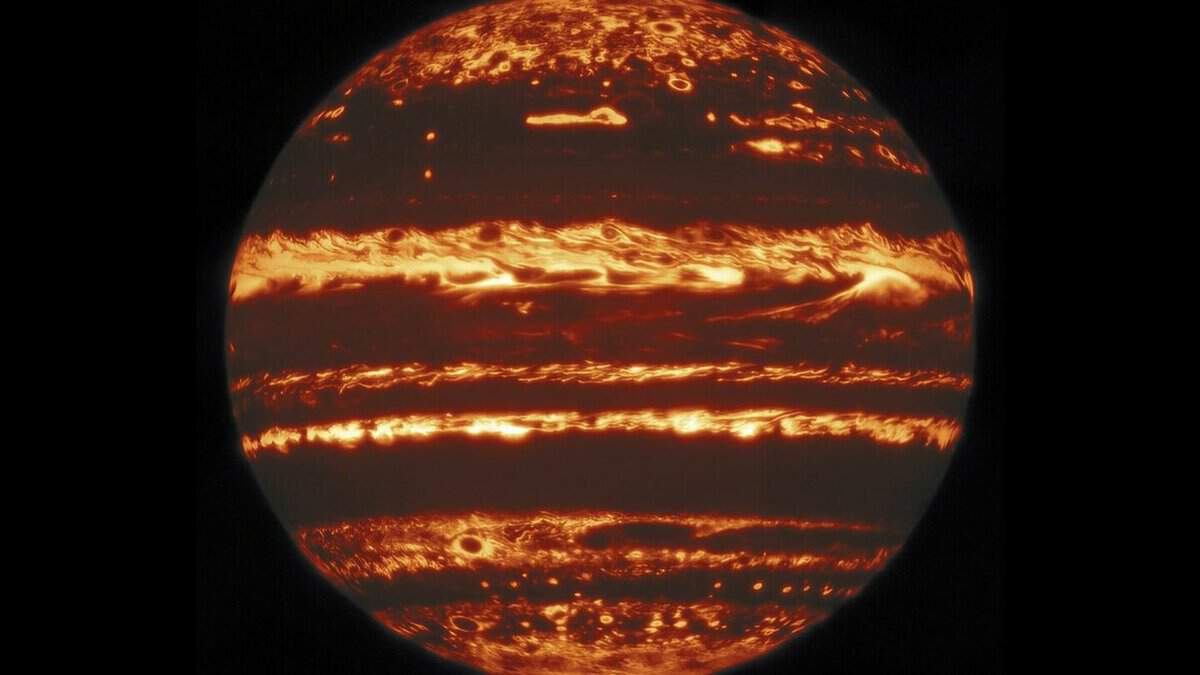
Cosmos
Jupiter, the fifth planet from the Sun, is a gas giant and the largest object in our solar system. It is a subject of great interest for astronomers, who frequently send probes to collect data about this celestial body. Over the years, significant research has been conducted, allowing us to form a comprehensive understanding of Jupiter.
Basic details about Jupiter
Jupiter, also known as the fifth planet in our solar system, is classified as a gas giant. This celestial body was named after the prominent ancient Roman god who presided over the heavens and governed the other gods.
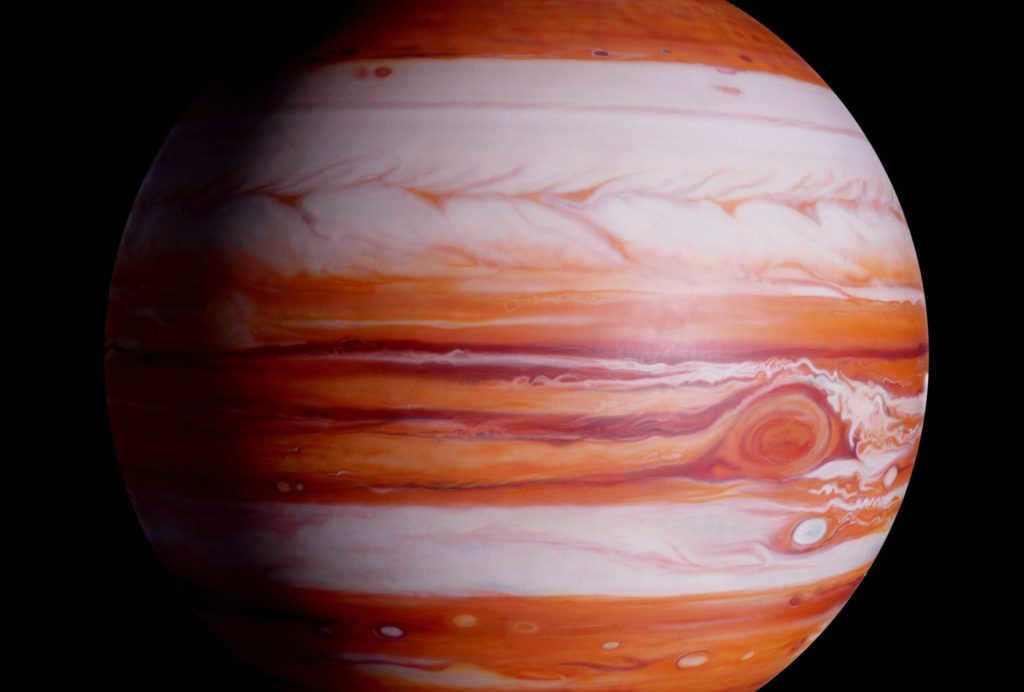
Throughout its existence, Jupiter has managed to amass a considerable number of satellites. Currently, it has a total of 79 moons. Due to its immense size, the planet was highly regarded by ancient civilizations. In Greece, it was often referred to as the “Star of Zeus”, while Chinese astronomers meticulously documented the giant’s trajectory for a period of twelve years.
Jupiter is positioned between Saturn and Mars in our solar system. The planet is composed of multiple layers, including an atmosphere and a core. Additionally, its magnetic field takes on the shape of a flattened disk.
Did you know? Jupiter is known for its high levels of background radiation. The Galileo spacecraft, which orbited the planet, received a radiation dose that was 2500% higher than the critical level on Earth.
Dimensions
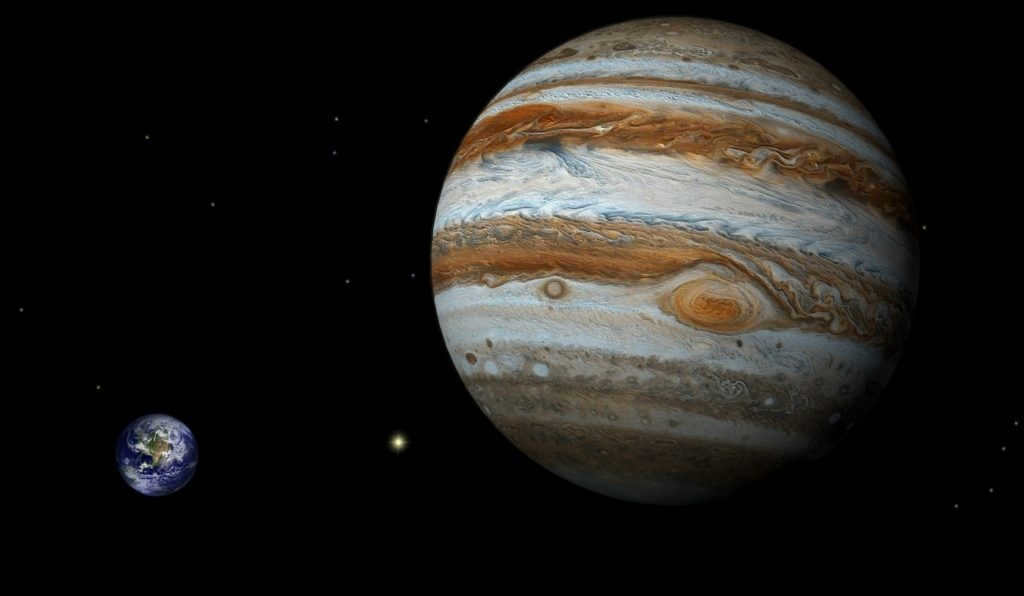
Jupiter is the largest planet in our solar system, with a radius of 69,911 kilometers. To put that into perspective, the second largest planet, Saturn, has a radius of 57,350 km.
Scientists attribute Jupiter’s massive size to its position as the first planet to form near the Sun. During its formation, Jupiter absorbed a significant amount of matter and gas from the surrounding environment billions of years ago. Although the solar wind eventually dispersed most of the material, Jupiter managed to retain some objects in its vicinity.
Here’s an interesting fact: Jupiter’s mass is twice as large as the combined mass of all other objects in the solar system, excluding the Sun itself.
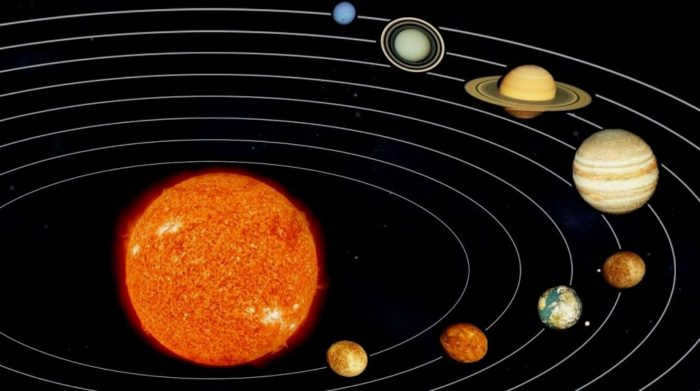
Jupiter orbits the Sun in an elliptical path. It takes almost 12 Earth years for Jupiter to complete one full revolution around the Sun. The average distance between Jupiter and the Sun is approximately 778 million kilometers. Jupiter’s velocity in space is about 46,800 km/h, and its direction of movement aligns with most of the other planets in the solar system. The only exceptions are Venus and Uranus, which move in the opposite direction.
Jupiter’s Physical Traits
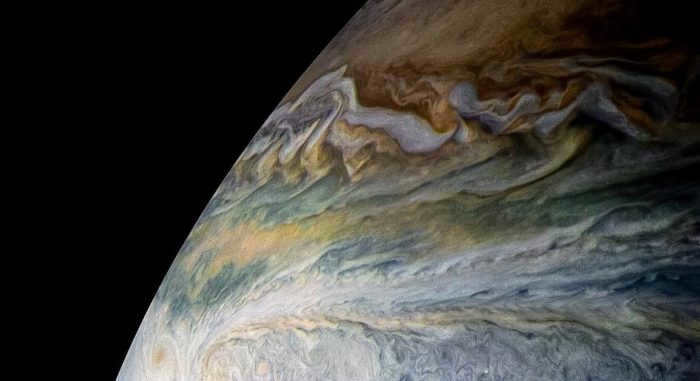
Due to the fact that Jupiter has assimilated the characteristics of numerous other planets, it possesses some rather intriguing physical attributes:
- The outer layer of Jupiter’s clouds exerts a pressure equivalent to one atmosphere, with a surface temperature of -107 degrees Celsius; as you delve 146 km below the surface, the pressure escalates to 22 atmospheres, accompanied by a temperature increase to +156 degrees Celsius;
- The average diameter of the planet amounts to 139,822 kilometers, which is eleven times greater than that of Earth;
- The planet’s surface area spans a staggering 62.18 billion square kilometers;
- Given Jupiter’s status as a gas giant, its density remains relatively low, at 1.33 g/cc;
- Thanks to its potent gravitational force, the acceleration of free fall on Jupiter reaches 24.8 meters per second;
- Jupiter’s mass totals 1898*E24, surpassing Earth’s mass by 318 times.
When it comes to several aspects, Jupiter stands out as the frontrunner among all the planets in our Solar System.
Makeup, Appearance, and Formation
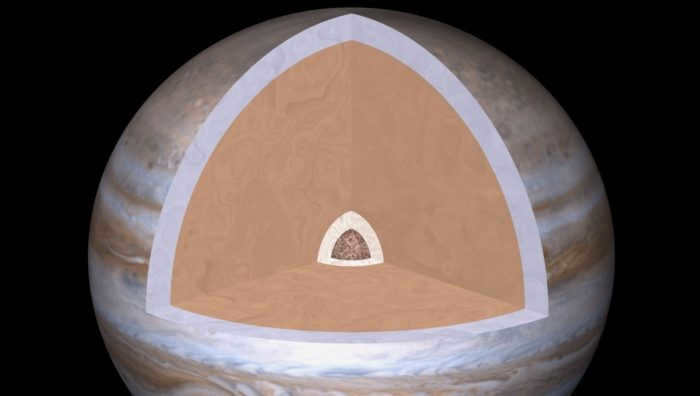
Jupiter is composed of a combination of liquids and gases. The predominant elements in its atmosphere are hydrogen, making up 92% of the composition, and helium, accounting for the remaining 8%. Other substances such as phosphine, sulfur, ethane, carbon, neon, hydrogen sulfide, and methane are present in smaller quantities above the planet’s surface.
Beneath the atmosphere, there is a layer of hydrogen gas that also contains dissolved helium and other substances. As one delves deeper into Jupiter, they would encounter a subsequent layer consisting of liquid hydrogen with similar impurities. Below that lies a layer of metallic hydrogen. Essentially, the gas giant is comprised of various states of hydrogen, each containing different substances.
Assuming that the core of Jupiter has a temperature of 35,700 degrees Celsius and a pressure of 4,500 GPa is a common belief. To put this into perspective, it is thought that on the surface the temperature is around 67 degrees Celsius and the pressure is about 10 bar. However, it is important to note that these values are purely theoretical and in reality, the actual parameters may vary significantly. These estimates are based solely on surface observations and remote study of the planet, as current spacecraft are unable to approach the outer layers due to intense radiation.
The atmosphere of Jupiter
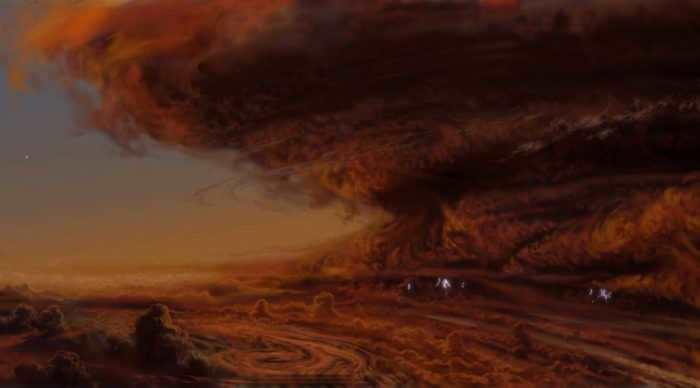
Jupiter, the giant gas planet, boasts an extensive atmosphere that stretches for 1,000 km. Within this atmosphere, the pressure ranges from 20 to 220 kPA, which is notably high. The majority of substances present above Jupiter’s surface is hydrogen, accounting for approximately 90% of the composition. Following hydrogen, helium is the second most abundant component, making up about 10% of the atmosphere. Other substances contribute to a small proportion of the overall composition.
Astronomers have categorized Jupiter’s atmosphere into distinct layers, starting from the uppermost layer and descending towards the lower layers.
While the composition of these layers remains relatively constant, there are variations in temperature and pressure. As one moves closer to the planet’s surface, the temperature gradually increases, while the pressure decreases. Notably, the troposphere stands out as a separate layer, where the phenomenon of polar lights occurs due to significant heat loss.
Due to variations in temperature, the prevalence of hydrogen, and extreme pressure, scientists occasionally witness auroras at the polar regions.
Jupiter’s Atmospheric Conditions
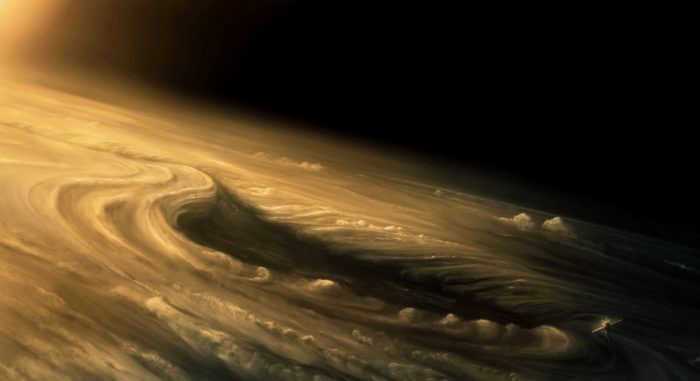
Storms and hurricanes are constantly present on the surface of Jupiter, with the ability to travel across the planet at speeds of up to 600 km/h. These storms and hurricanes can change their position and shape dramatically within just a few hours. The Red Spot, a massive storm that can be easily seen without being too close, is a clear representation of the turbulent weather on the planet. It is estimated to have lasted for several centuries in Earth time.
The majority of Jupiter is covered by thick clouds in shades of white and brown. These clouds form distinct bands with defined boundaries and move at different speeds. Astronomers refer to these bands as tropical regions. The formation of these bands is a result of the chaotic air patterns at various altitudes.
Indeed, Jupiter experiences a perpetual tempest of impenetrable clouds that possess distinct dimensions, temperature, and atmospheric pressure.
Jupiter’s atmospheric temperature
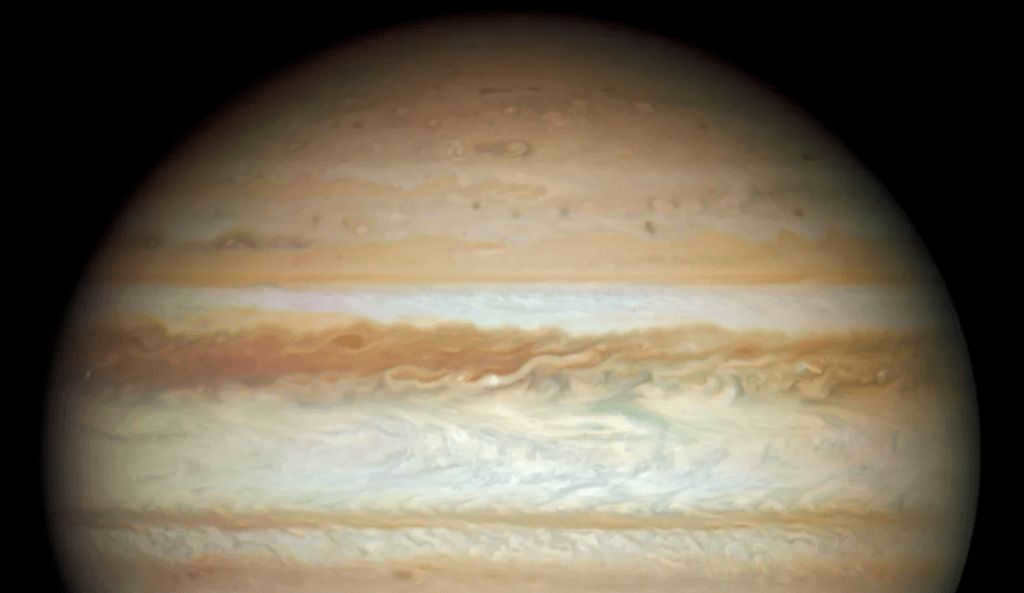
The temperature on Jupiter differs significantly across its layers. Additionally, this characteristic can exhibit substantial variation even within a single layer, contingent upon prevailing conditions. Given the constraints imposed by the planet’s intense radiation, scientists are occasionally left to conjecture the thermal conditions prevalent in specific regions.
It is widely believed that the core of the gas giant experiences incredibly high temperatures, with the inside temperature potentially reaching a scorching 35,700 degrees Celsius. Surrounding the core is a dense layer of liquid metallic hydrogen. Despite the challenges astronomers face in studying this region, there is enough available data to make predictions about its temperature. The transition of metallic hydrogen from a solid to a liquid state requires significant heat, but the immense pressure on Jupiter allows for temperatures ranging from 6,000 to 21,000 degrees Celsius.
On the surface of this massive planet, extremely cold temperatures prevail, dipping as low as -170 degrees. The lower layers of its atmosphere maintain relatively consistent temperatures, with an average of -145 degrees.
Jupiter boasts the largest number of satellites among all the planets in the solar system. It was Galileo who first spotted one of its moons back in 1610 using his groundbreaking telescope. As he turned his lens towards the planet, he couldn’t help but notice four luminous specks orbiting around the massive celestial body. What’s truly remarkable is that these dots were aligned in a row and moved steadily in sync with the planet.
Fascinating tidbit: The discovery of these satellites by Galileo served as evidence that not everything in the universe revolves around our Earth. Unfortunately, this revelation led to persecution by the Catholic Church, as they staunchly maintained that our planet holds the central position in the universe.

The initial set of four satellites were given the name “Galilean satellites” and consist of:
- Io. The celestial body closest to Jupiter, with a diameter of 3,642 km. Its surface is yellow in color due to its high sulfur content, and it boasts over 400 active volcanoes, which is a record among all objects in the solar system.
- Europa. This satellite is well-known for its smooth surface. It has a diameter of 3,120 km, and is largely devoid of craters. However, it does have cracks and streaks that give it a gray-brown color.
- Ganymede is the largest moon in the solar system, measuring 5,268 km in diameter. Its surface is dotted with craters and rocky areas. It appears gray in color due to the presence of silicate rocks and icy lakes. Speculation suggests that there may be liquid water beneath the icy surface.
- Callisto has a diameter of 4,820 kilometers and is composed of a mixture of ice and rocks. It is not surrounded by strong radiation, making it a potential site for a future research station to study Jupiter.
After the discovery of the four moons by Galileo, astronomers continued to find additional satellites influenced by Jupiter’s gravity.
The Enormous Crimson Spot
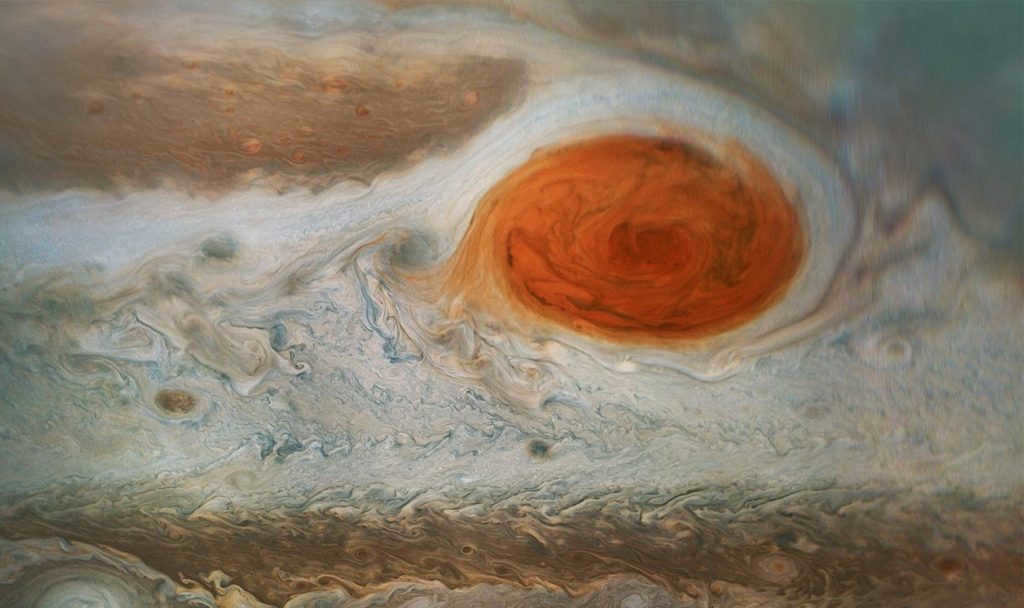
Because of its rapid rotation, Jupiter experiences frequent hurricanes on its surface, characterized by distinct cloud colors. These storms manifest as long streaks and other high-speed moving areas.
Astronomers discovered the Great Red Spot on Jupiter in 1664. This massive storm has persisted ever since.
However, long-term observations indicate that the size of the hurricane has gradually decreased since 1930. Furthermore, the spot is shrinking at an accelerating rate with each passing year. It is possible that in a few decades, it will become difficult to discern without the aid of high magnification.
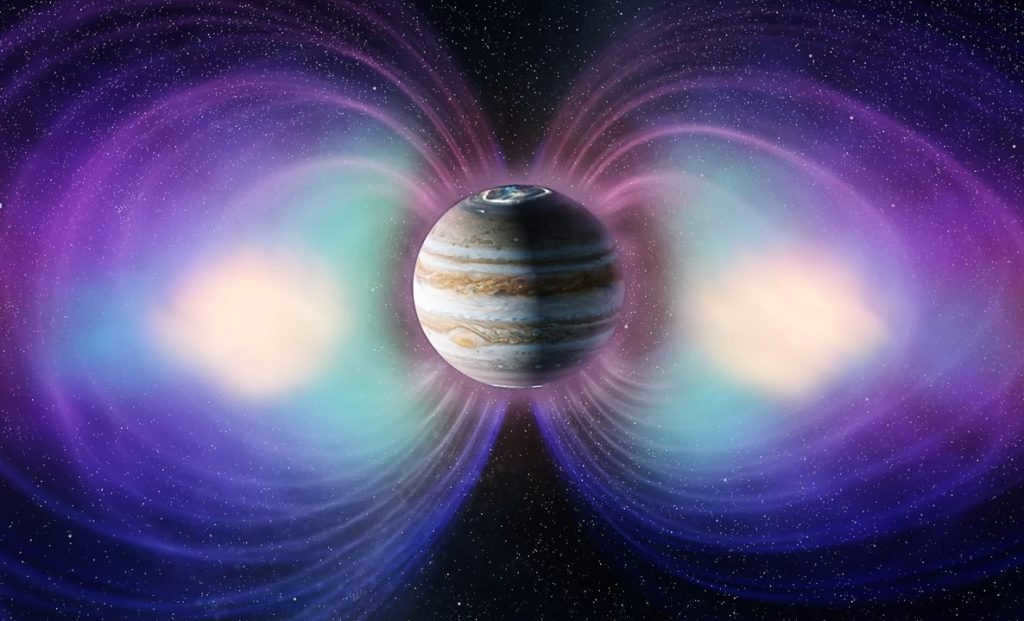
Due to the immense internal pressure of the planet, the dominant element in Jupiter, hydrogen, exists in a liquid form. The electrons present in this liquid hydrogen serve as highly efficient conductors of electricity. This, in combination with the planet’s rapid rotation, results in the generation of an incredibly strong magnetic field. This magnetic field has the ability to attract charged particles, which are carried by solar winds and can be found within Jupiter’s satellites. Some of these charged particles create stunning auroras at the planet’s poles, while others become accelerated to remarkable velocities, ultimately forming radiation belts. In fact, the radiation found within these belts is the most potent in the entire solar system.
The rings of Jupiter
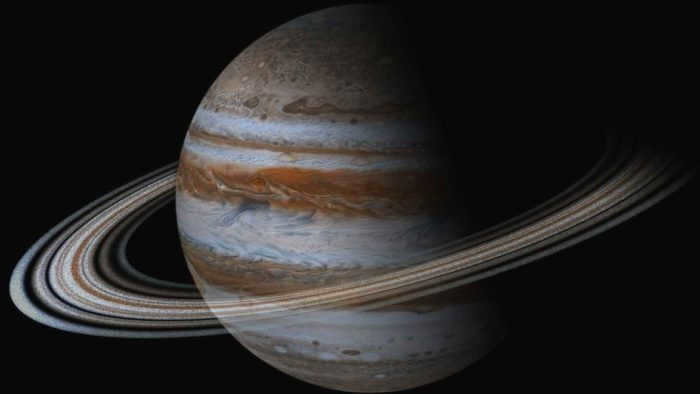

Jupiter possesses a set of rings, although they are not as prominent as the rings surrounding Saturn. These rings are predominantly made up of dust particles and fine debris, which are held together by the gravitational pull of the gas giant.
Scientists hypothesize that Jupiter’s rings were formed as a result of frequent collisions between its moons and asteroids. Upon impact, small objects were ejected into space and subsequently drawn towards the planet, eventually coalescing into the ring structure due to its high rotational velocity.
Measuring the Distance to the Sun and Earth
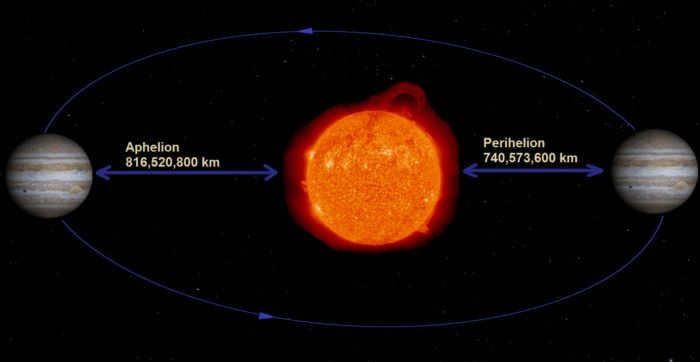
The star has a minimum distance of 740.57 million km (perihelion) and a maximum distance of 816.52 million km (aphelion). When the star is closest to Earth, it is at a distance of 588 million km, and it can be as far as 967 million km away. The optimal time to observe the star is every 13 months. In 2019, it was closest to Earth on June 10, and in 2020, Jupiter will be close on July 10.
Period of Orbital Rotation
Jupiter completes one revolution around the Sun in 4,331 days, moving at a velocity of 13 km/s. The orbit of this massive planet is inclined by 6 degrees in relation to the Sun’s equator. Due to its immense size, Jupiter’s center of mass is located outside the star.

Due to its highly visible presence in the sky, Jupiter has been given various names since ancient times. The Romans chose to nickname this celestial giant after their god of sky and thunder. Despite the introduction of Christianity in the region, the ancient myths became deeply ingrained in the daily lives of the people, making it impossible to eradicate them. This is also reflected in the field of astronomy. Even today, numerous stars, planets, and galaxies are named after ancient gods, and Jupiter is no exception.
The exact appearance of Jupiter is difficult to determine. As the planet is composed entirely of gases and technology fails when attempting to approach its surface, scientists are unable to collect soil samples or conduct any analysis.
The Formation of Jupiter

Jupiter came into existence by accumulating hydrogen and helium from the surrounding space during the early stages of the solar system. Through a gradual process of collision and merging between small particles, it eventually transformed into a colossal gas giant.
Due to its immense size, scientists hypothesize that Jupiter formed prior to the objects in the Earth’s group, as it had no obstacles in absorbing gas from the surrounding space.
Preliminary estimations suggest that the formation of Jupiter took place over a span of several million years, as the gases gradually coalesced to create a vast celestial sphere.
History of Exploration
The planet can be easily observed from Earth, which is why its existence has been known since ancient times. As early as the 8th century BC, Babylonians were aware of Jupiter’s presence. In the 2nd century, Ptolemy developed a geocentric model and calculated that Jupiter completes one revolution around the Earth every 4332 days. Several centuries later, the mathematician Ariabhata replicated the astronomer’s experiments and further refined the rotation period to hours.
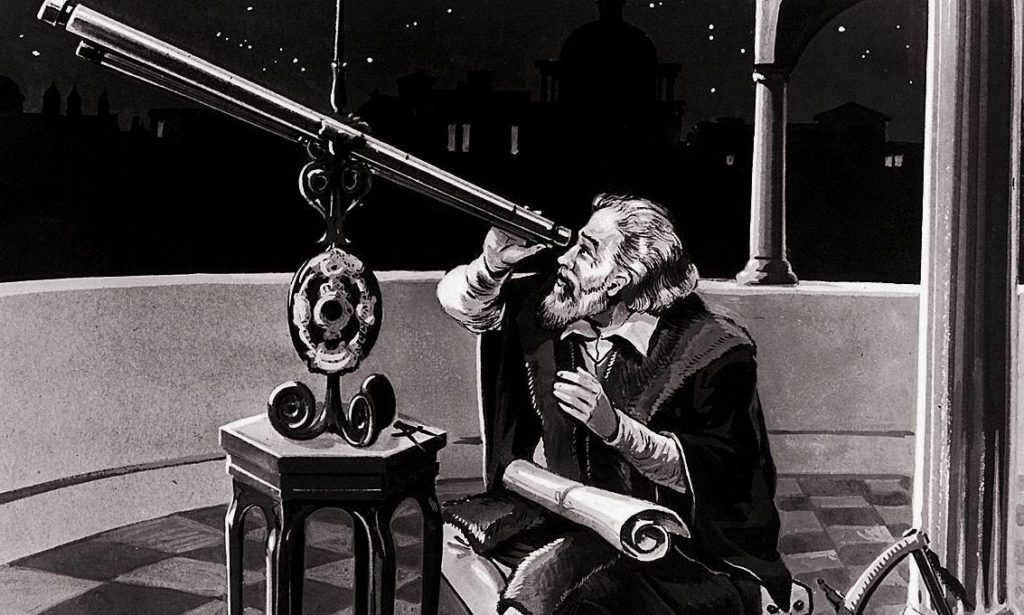
In the early 17th century, Galileo utilized an innovative telescope to observe the gas giant known as Jupiter. During his observations, he made a groundbreaking discovery – the presence of four satellites orbiting around the planet. This finding challenged the prevailing belief that all celestial bodies revolved around the Earth and provided support for the heliocentric model, which posits that the planets orbit the Sun.
A few decades later, in the 1660s, the astronomer Cassini embarked on a study of Jupiter using an improved version of the telescope. This upgraded instrument allowed for greater magnification, enabling Cassini to delve deeper into his observations. In his research, he not only observed Jupiter’s rotation around its axis but also identified distinct atmospheric zones that exhibited varying rotational speeds.
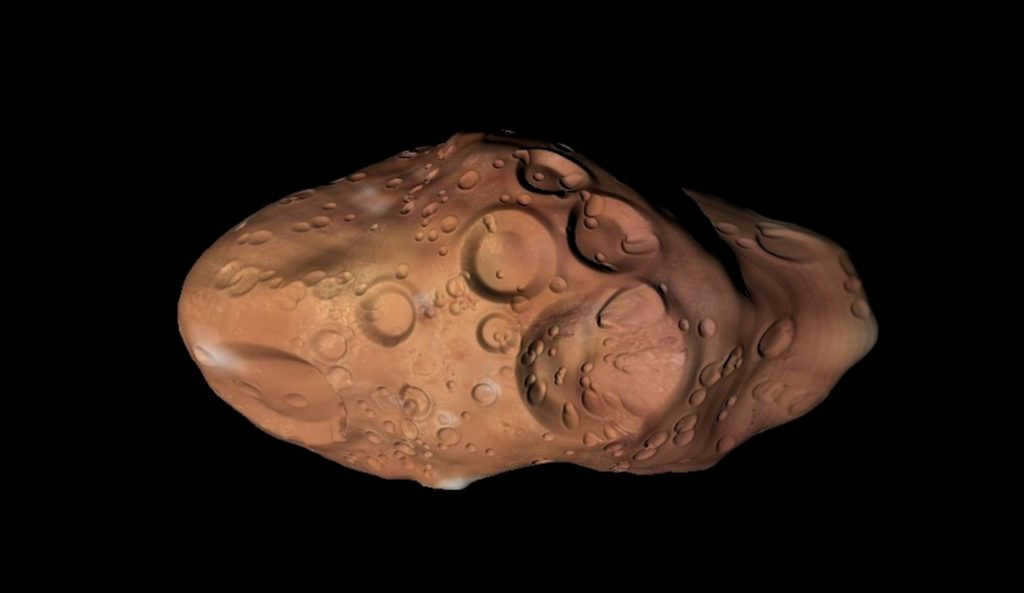
The discovery of the fifth satellite of Jupiter, Almathea, occurred in 1892 when E. Bernard observed it through a telescope. In 1955, the precise rotation speed of the gas giant was determined thanks to the study of radio waves and their interaction with celestial objects.
From the second half of the 19th century until now, there has been an ongoing observation of Jupiter. Astronomers continuously collect information about this celestial body in an effort to create a comprehensive understanding of it. However, technology still has a significant distance to cover before space probes can approach Jupiter’s surface closely.
An Engaging Video on the Fascinating Aspects of Jupiter
In case you come across any inaccuracies, kindly make a note of the text and utilize the Ctrl+Enter command to notify us.
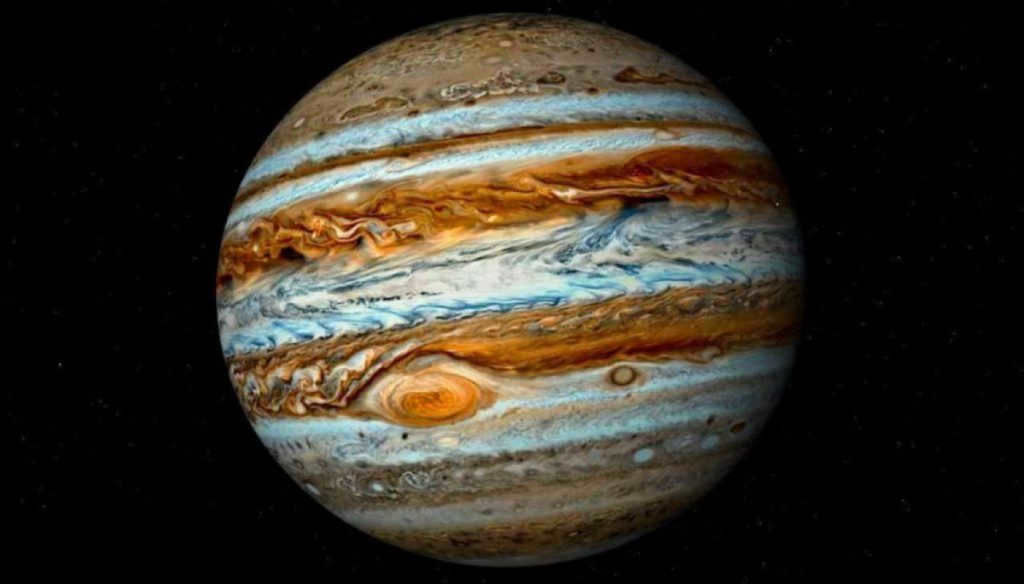
Jupiter has been known as one of the five planets for a very long time.
Details about Jupiter
Jupiter’s diameter is 11.2 times that of Earth, its volume is 1300 times larger, and its mass is 317.8 times greater. It takes just under 12 Earth years for Jupiter to complete one orbit around the Sun. Jupiter is a giant gas planet with no solid surface, with its atmosphere composed of 90% hydrogen and 10% helium. Its solid core, which is about the size of Earth and accounts for approximately 4% of the planet’s total volume, is present.
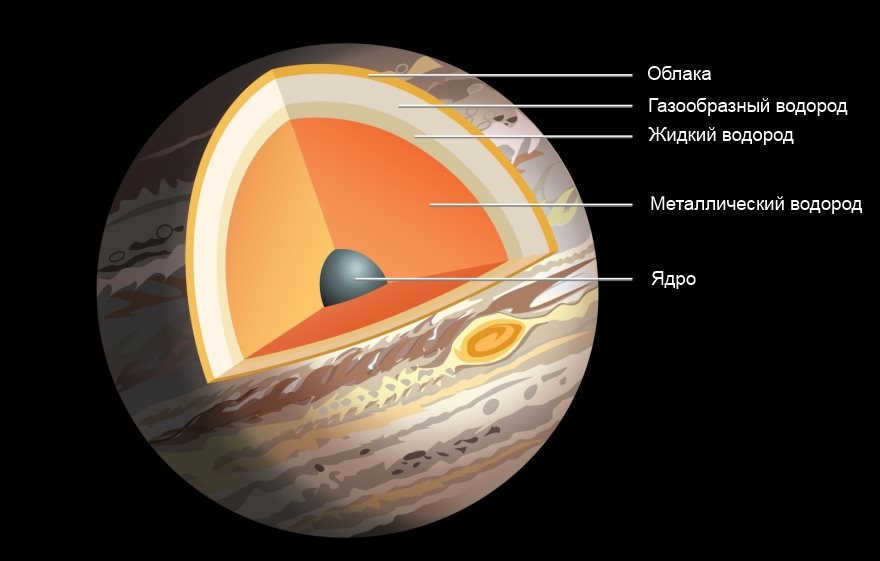
When should you observe?
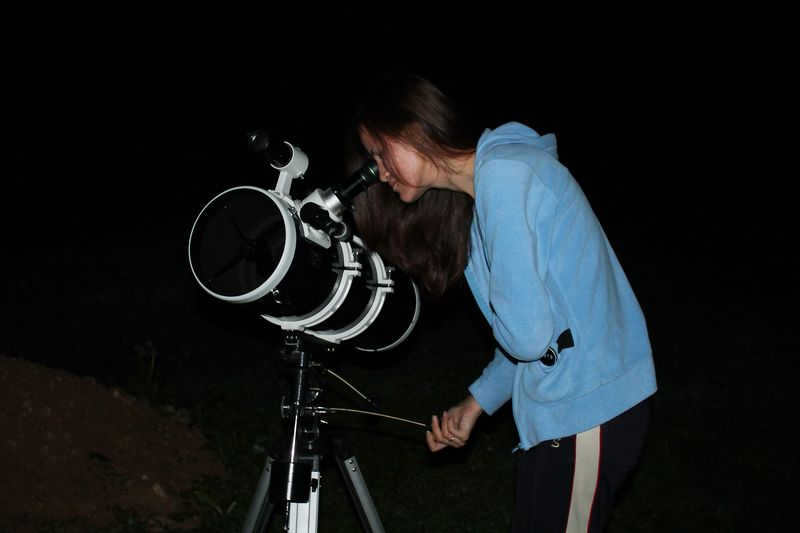
The optimal time to observe Jupiter is during its opposition, which occurs when the planet is at its closest distance to Earth. This event takes place every year and the timing of each opposition shifts approximately one month ahead of the previous one. Here are the upcoming oppositions:
During summer oppositions, Jupiter appears low on the horizon (not exceeding 30 degrees for latitudes in Russia). On the other hand, winter oppositions offer a more favorable viewing experience as Jupiter rises high above the horizon and remains visible throughout the night. During winter, it is possible to observe the complete rotation of the planet around its axis.
Observing the Wonders of Jupiter
The atmosphere of Jupiter is in a constant state of flux, with turbulent vortices creating a dynamic and ever-changing appearance. However, amidst this chaos, there are discernible patterns and stable structures that can be observed in the planet’s atmospheric composition.
The Fascinating World of Belts and Zones
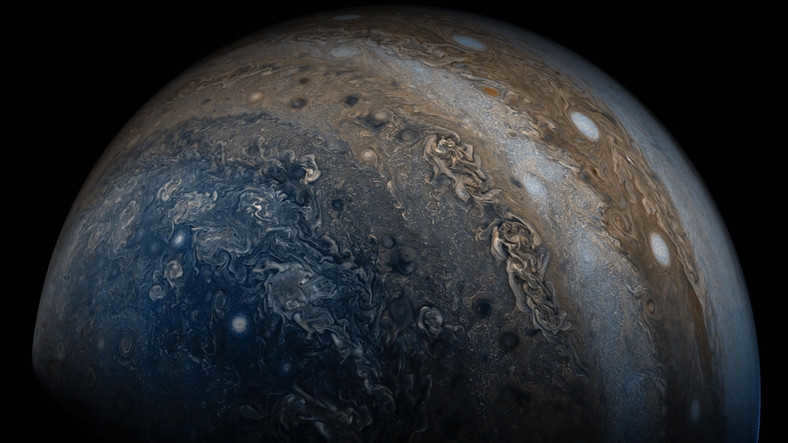
The upper clouds of Jupiter form parallel bands around its equator. These bands are known as zones, with the lighter bands referred to as zones and the darker bands referred to as belts.
Located just above and below the equator are the Northern and Southern Equatorial Belts. Moving further away from the equator, we find the Northern and Southern temperate belts. Between the equatorial and temperate belts, we can observe the Northern and Southern tropical zones. At the poles, there are also dark polar caps that are visible.
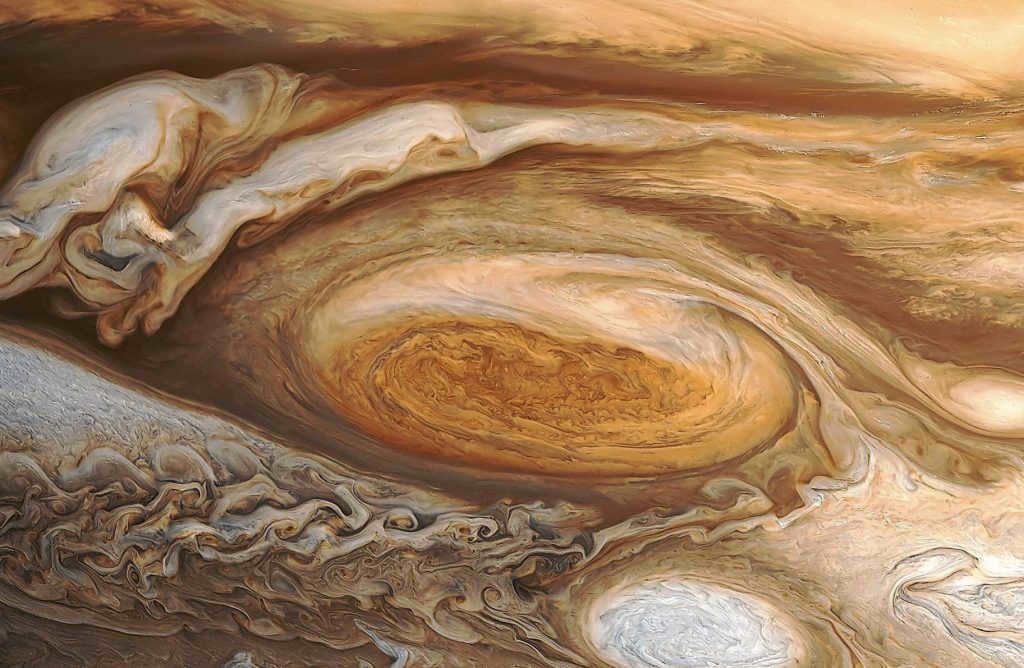
Jupiter’s Great Red Spot
The Great Red Spot is a massive swirling storm in Jupiter’s atmosphere. Situated in the Southern Tropical Zone, it has an oval shape and stands out with its vibrant pink color against the rest of the planet’s disk.
In the Southern Temperate Belt region, there are three distinct White Spots. These spots are formed by the accumulation of gaseous liquids and are challenging to observe due to their white coloration.
Satellites, eclipses, and the extent of coverage
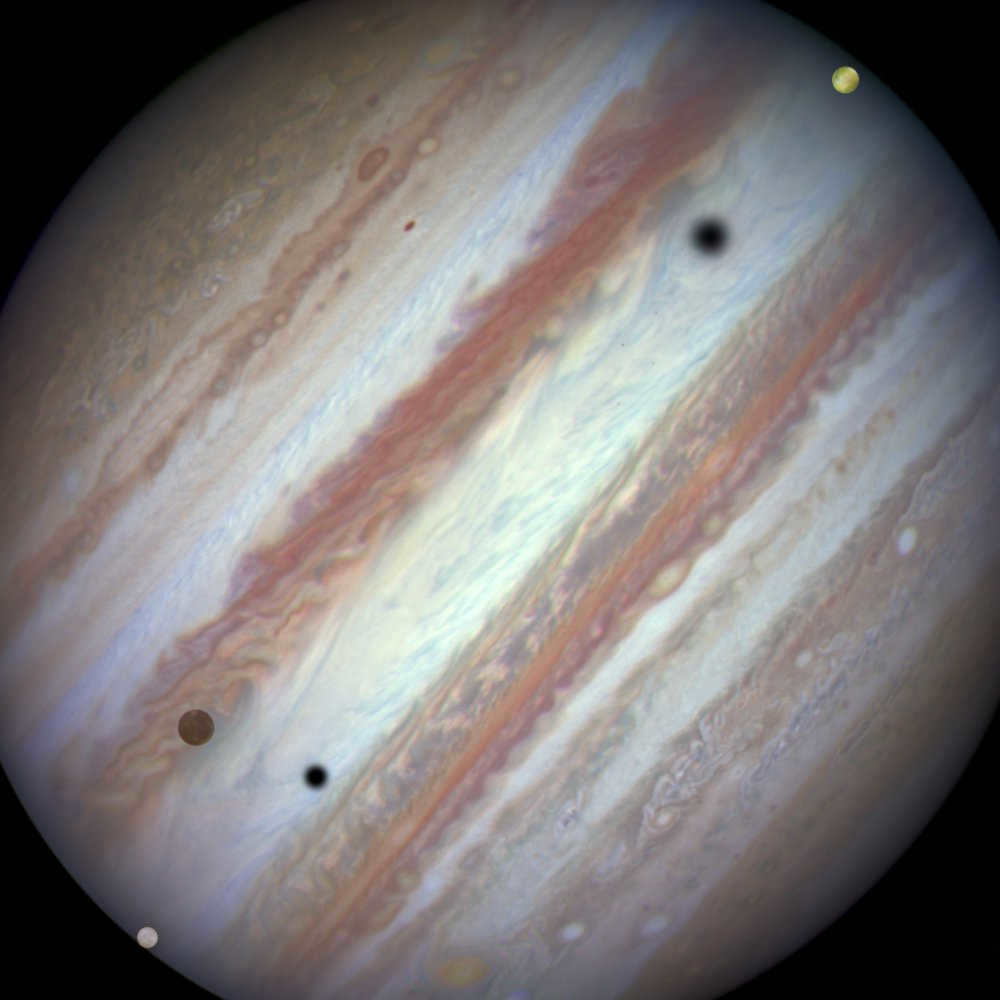
Witness a rare phenomenon – a triple solar eclipse on the planet Jupiter.
Visible near Jupiter’s disk are four satellites: Io, Europa, Ganymede (the largest), and Callisto. These satellites were first discovered by Galileo and have been a subject of fascination ever since. As you observe, you will notice the rapid rotation of these satellites around Jupiter, with their positions changing noticeably in just half an hour.
What makes this spectacle even more captivating is the passage of shadows from the satellites across the planet’s disk. Pay close attention and you will see that the shadows of the two closer satellites have a sharper outline, while the shadows of the two distant satellites have less clear, blurred boundaries.
Equipment for Observations
If you want to observe the tiny disk of Jupiter, you will need binoculars with a minimum magnification of 7x. If you increase the magnification, you will be able to see Jupiter’s Galilean satellites. However, for more detailed observations, it is necessary to use a telescope.
When observing planets like Jupiter, it is common to use telescopes, specifically refractors with an aperture (the diameter of the collecting lens or main mirror) ranging from 120 to 150 millimeters.
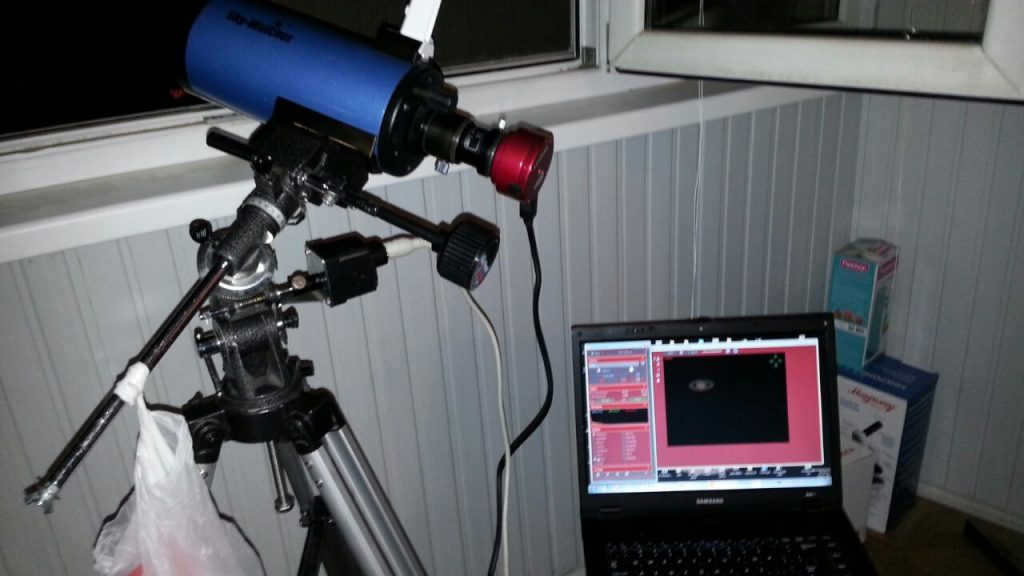
Equipment for observing
With a 60-millimeter telescope, it is possible to observe the bands on Jupiter, while an 80-millimeter telescope allows for the observation of finer details such as light and dark spots, depressions along the edges of the bands, protrusions, transverse connecting “bridges” between the bands, as well as the Red Spot and the shadows of the planet’s satellites on its surface.
A 150-millimeter telescope provides the opportunity to observe even finer details and notice differences in the size of the satellite shadows. The highest level of detail can be observed with a 300-millimeter telescope, although with a larger lens diameter, the image may become slightly blurred due to atmospheric movement.
To enhance the contrast and draw attention to specific elements in the background, try utilizing light filters. For instance, applying blue and blue light filters can improve the visibility of the Red Spot and belts featuring red-brown hues, while using a red filter will accentuate any details with a blue tint. Feel free to experiment with different light filters to achieve a sharper image of the intricacies.
Enjoyed this article? Share it with your friends!
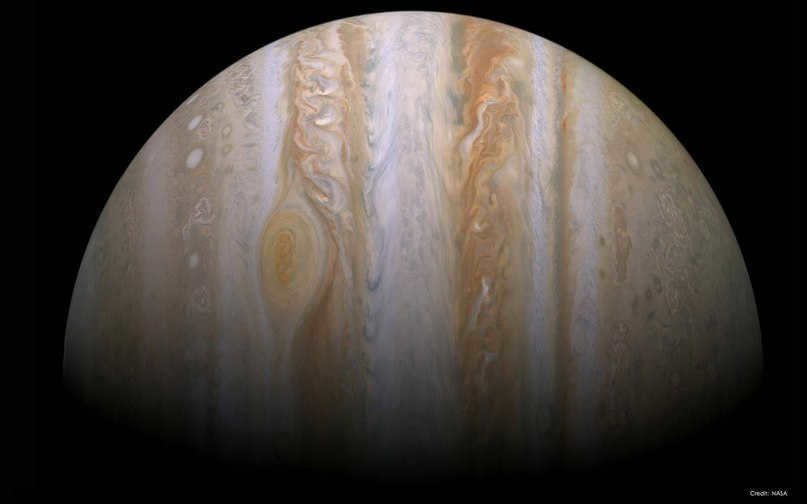
When observing a celestial object composed of compacted matter and possessing a clearly defined outer layer, it is a simple task to approximate its dimensions.
The predicament of ascertaining a planet’s magnitude
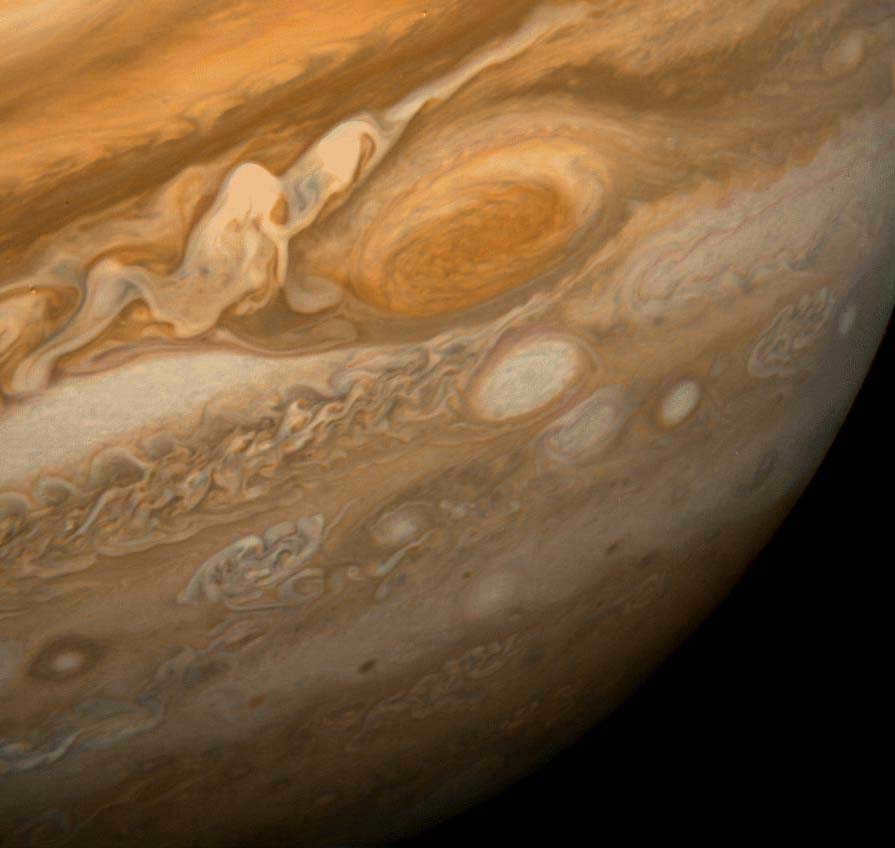

Jupiter’s cloud layer is a fascinating sight to behold, as captured in this Voyager image. However, determining the actual size of this massive ball of gas presents a unique challenge. Within its depths, chemical elements undergo phase transitions, transforming from solid to gaseous states, boiling, erupting, and vaporizing. These processes occur at boundaries that are hidden from our view, nestled beneath the dense clouds that form in the planet’s upper layers. Consequently, we are unable to directly observe these phenomena from Earth and must rely on research data to make educated guesses. Therefore, when estimating the size of Jupiter, scientists draw its outline based on the visible boundary of these captivating clouds.

An approximate comparison between the sizes of the planets and the Sun can be made. In terms of diameter, this gas giant is roughly 11.2 times larger and 318 times heavier than Earth. Its size is truly remarkable. Even if all the other planets were combined, the resulting object would still be 2.5 times smaller than this enormous gas giant.
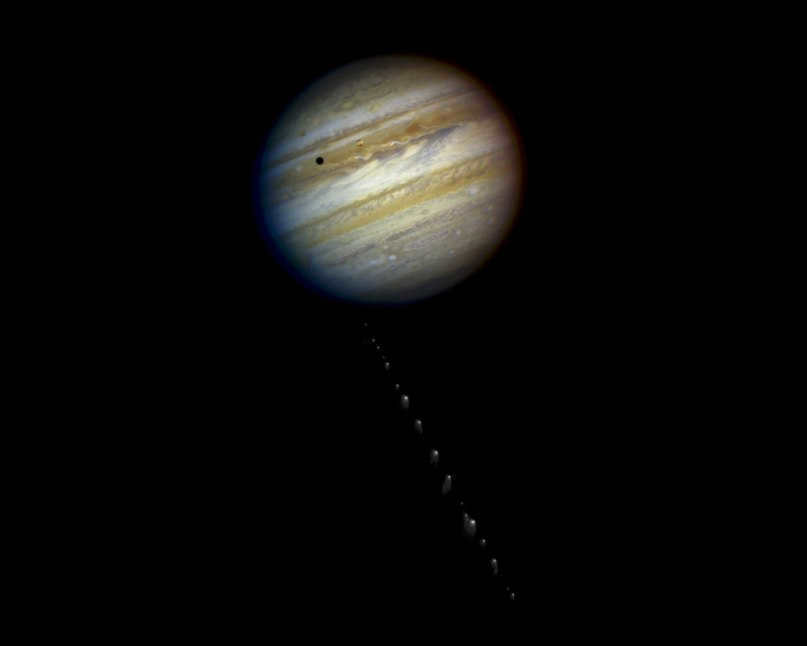
A composite image showing the fragments of a comet and their interaction with Jupiter’s powerful gravitational field. In 1992, the comet, located relatively close to Jupiter at a distance of about 15 thousand kilometers, broke apart into several pieces. These fragments eventually fell into Jupiter’s atmosphere. Without the presence of this gas giant, which acts as a gravitational “umbrella” in space, a much larger number of potentially dangerous celestial bodies would be able to reach Earth, posing a significant threat to life.
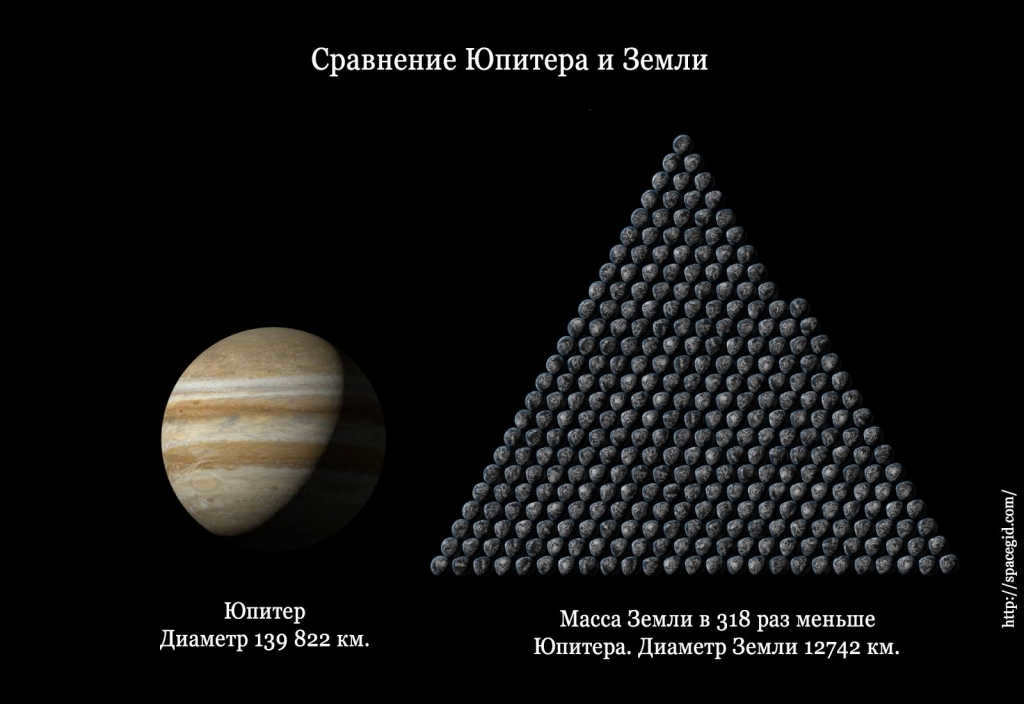
Comparison of the sizes of Jupiter and Earth
To describe the dimensions of this planet, we can refer to its equatorial and polar radii, which measure 71,492 km and 66,854 km respectively. Jupiter is slightly distorted at its poles, a phenomenon that can be attributed to its rapid rotation. The planet completes one full rotation around its axis every 9.925 hours. This rotation generates centrifugal forces, causing the planet to stretch more as you move away from its axis of rotation and closer to its equatorial plane. Consequently, Jupiter has assumed a distinctive shape known as an oblate spheroid.
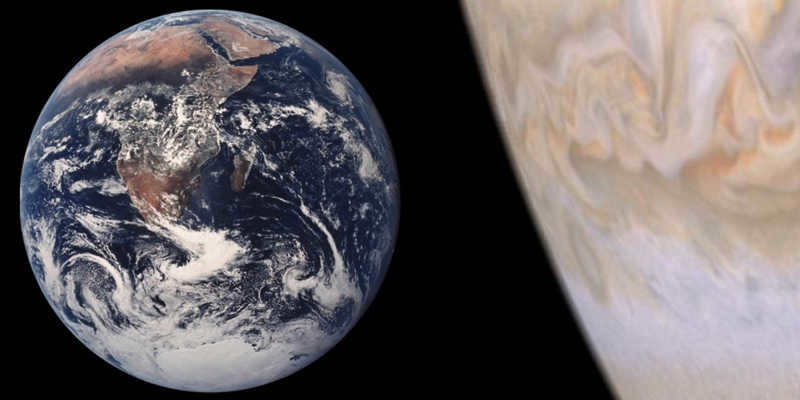
Comparison between Earth and Jupiter
To simplify mathematical calculations, Jupiter, the gas giant, is often represented as a sphere with a diameter of 139,822 km. The planet’s surface area is 6.21796×10*10 km2, which is 122 times larger than that of Earth. To truly grasp the enormity of Jupiter’s scale, one only needs to consider the famous Red Spot, which has fascinated and continues to fascinate scientists. It is believed that the length of this unique atmospheric phenomenon is between 24 and 40 thousand kilometers, while the average radius of Earth is only 6371 km. This means that two or three planets like ours could fit inside this spot alone.
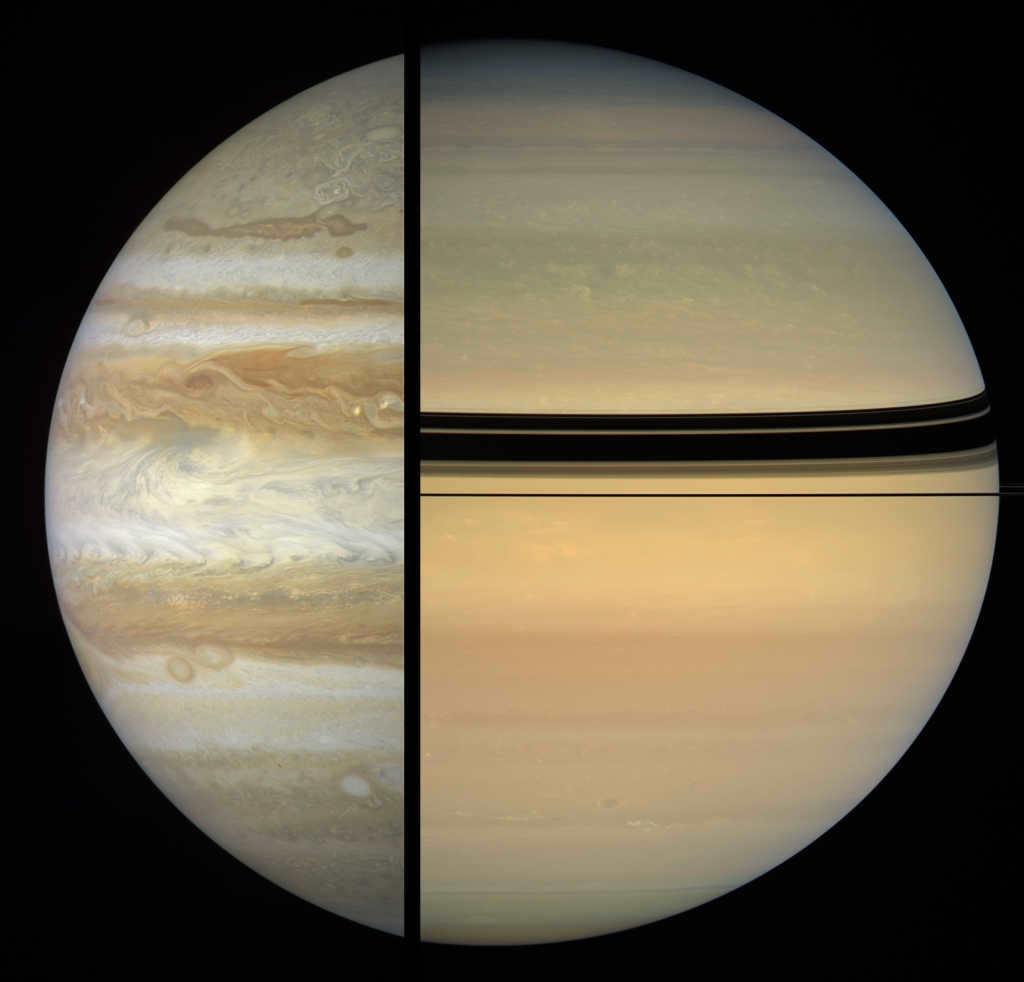
Comparison of Jupiter and Saturn. The proportions are incorrect.
It’s highly unlikely that our gas giant is so exceptional that it doesn’t have any larger counterparts in other stellar systems and galaxies. The theory suggests the existence of hot “Jupiters” in outer space – planets with similar composition and size to the planets in our solar system, but with surface temperatures ranging from 1,000 to 3,000 K. These celestial bodies are located closer to their star, resulting in higher temperatures. By the way, if Jupiter were in similar conditions, its size would be significantly larger than it currently is.
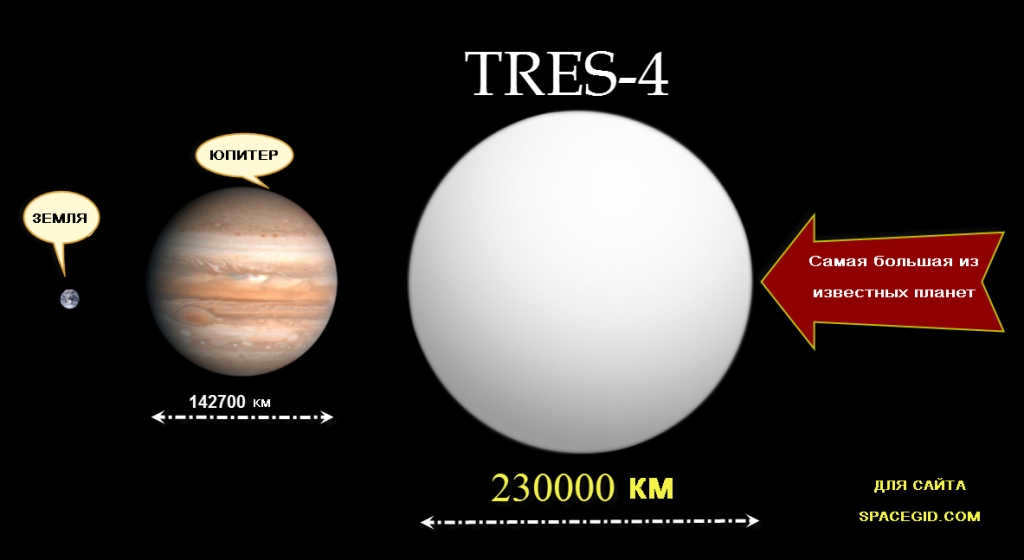
The largest planet ever discovered is Jupiter. Astronomers occasionally find exoplanets, some of which are hot gas giants. However, only one of these exoplanets has been found to be larger than Jupiter in size, although it is smaller in mass. This exoplanet, named TrES-4, is located in the constellation Hercules. While there have been other reports of large gas giants, scientists have not yet reached a consensus on the accuracy of the data. These observations are conducted at the limits of current technology, which introduces the possibility of errors.
Nevertheless, the immense atmosphere of Jupiter is truly remarkable!
The solar system is home to a variety of celestial bodies: Mercury, Venus, Earth, and Mars are classified as rocky planets due to their similar composition. On the other hand, Jupiter, Saturn, Uranus, and Neptune are gaseous planets that reside in the outer region of our star system, beyond the orbit of Mars and the asteroid belt. This distinction effectively splits the solar system in half, and for a long time, Jupiter has been considered the cause. However, this gas giant is not just a mere “divider” but also a subject of growing interest. Recently, the newest space observatory named “James Webb” captured images of Jupiter, revealing the presence of thin rings encircling the planet. It is worth mentioning that Webb observes space in the infrared spectrum, allowing it to explore both the farthest corners of the universe and the celestial bodies within our own star system.
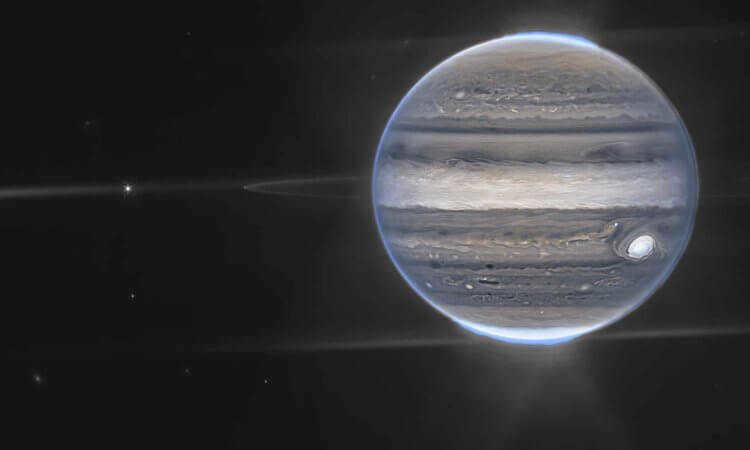
Jupiter captured by the powerful James Webb Space Telescope
What is the appearance of Jupiter?
The gas giant that dominates the solar system is composed mainly of hydrogen and helium enveloping a solid core made of ice and rock. This immense planet is easily visible from Earth with a regular telescope, appearing as a vivid reddish star. It is easily recognizable by its famous feature, the “Great Red Spot,” caused by intense atmospheric pressure and towering clouds.
The turbulent and cloudy atmosphere of Jupiter gives rise to the phenomenon known as the Great Red Spot. This massive and long-lasting hurricane boasts wind speeds reaching up to 402 kilometers per hour and has been documented to last for at least 300 years, according to Russian cosmonaut Sergey Ryazansky, Amazing Planets.
NASA’s Cassini spacecraft captured the first composite image of Jupiter as it approached the planet in 2000. This photo is a combination of twenty-seven individual images, revealing intricate details such as the distinct red and white stripes, the iconic Great Red Spot, and cream-colored ovals.
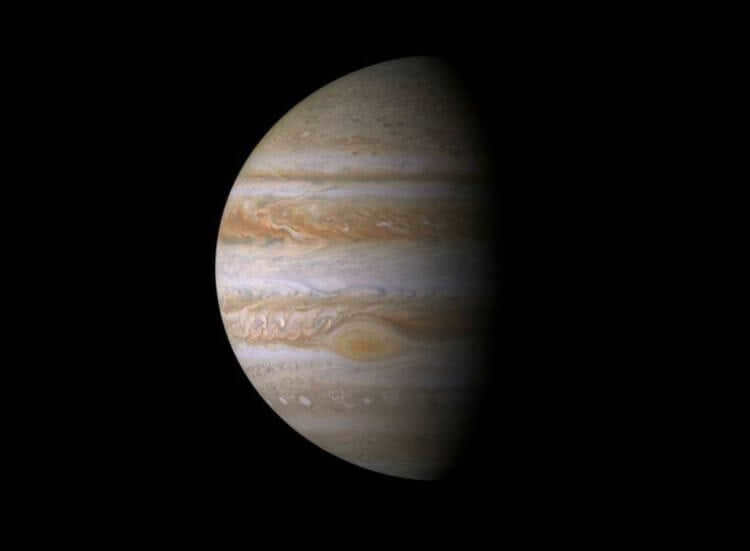

Jupiter does not have a solid surface beneath its clouds, unlike the planets in the Earth group.
Do you want to stay updated with the latest news in the world of science and technology? Subscribe to our news channel on Telegram! This way, you won’t miss out on anything interesting!
The world got its first glimpse of Jupiter in 1979, when the Voyager 1 and Voyager 2 spacecraft approached the gas giant. Both spacecraft are currently far away from Earth and will soon lose communication. I have shared more about the adventures of these space explorers here, which I recommend you to read.
In 2007, the New Horizons spacecraft transmitted pictures of Jupiter’s four largest moons to Earth. Astronomers refer to these moons as the Galilean moons: Io, Europa, Ganymede, and Callisto. These moons are some of the largest satellites in the solar system and can be observed using a small telescope.
Launching various spacecraft, such as probes and telescopes, into space provides the most effective means of studying the solar system and its planets. Thanks to these images, we have discovered, among other things, Jupiter’s aurora borealis during solar storms. When streams of electrons collide with Jupiter’s atmosphere, the molecules release additional energy in the form of light, resulting in the creation of auroras.
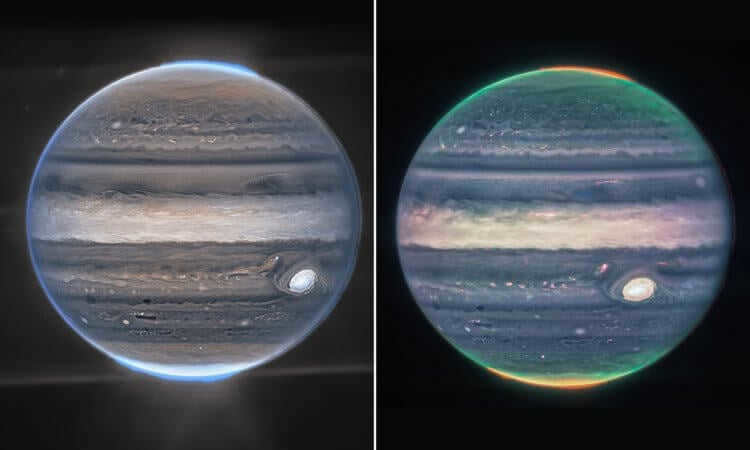

A composite image of Jupiter captured by NIRCam
The images reveal various shades of blue in the clouds deeper within Jupiter’s atmosphere. Additionally, the Great Red Spot appears white due to sunlight reflection. The Hubble Space Telescope has captured the majority of photographs of this gas giant, but it has now been replaced by the James Webb Space Observatory.
“James Webb” captured an image of Jupiter
Jupiter, the gas giant that is closest to Saturn, has unique icy rings that distinguish it from other celestial bodies in our solar system. These rings can be observed through a telescope, and Jupiter also has dozens of moons that orbit around it, similar to Saturn. Additionally, it has been discovered that Jupiter has its own rings, although they are difficult to see due to two reasons: Firstly, Jupiter only has two rings, and secondly, they are extremely thin.
It is worth mentioning that the “Webb” spacecraft is equipped with an infrared camera called NIRcam, which was used to capture an image of Jupiter. During the process, the researchers matched each wavelength of infrared radiation with a corresponding visible color: longer wavelengths were converted into shades of red, while shorter wavelengths were converted into shades of blue.
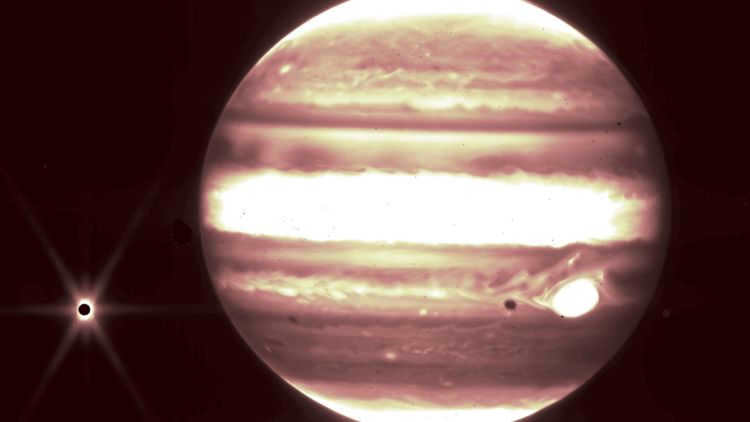

Jupiter as seen in infrared. The photo was captured by the NIRcam instrument on board the James Webb Space Telescope.
By combining multiple images, the team of the Webb Space Telescope has obtained a breathtaking view of this gaseous planet that we are accustomed to seeing in warm hues. However, in the new images, the gas giant appears pale and ethereal.
We have previously highlighted the accomplishments of the state-of-the-art James Webb Space Telescope, so make sure not to miss it!
A mysterious world
However, let’s return to the enigmatic rings of Jupiter, which pose a challenge when it comes to capturing their beauty on camera. Comprised of minuscule dust particles that possess limited light reflection, these rings leave astronomers curious about their origin. The prevailing theory suggests that the dust originates from Jupiter’s tiniest moons, of which there are believed to be at least 79 in total.
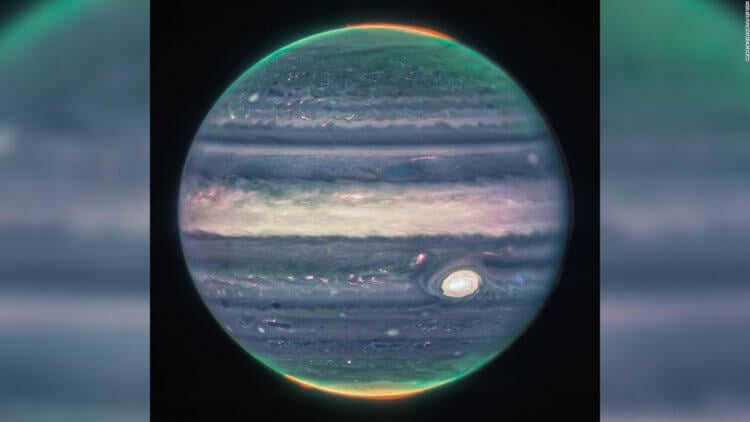
After applying filters, these images have a different color scheme and the planet appears darker.
The latest images of Jupiter also provide a glimpse into its turbulent atmosphere. “Even the Great Red Spot can’t hide from the infrared observatory and appears as a bright white spot in the photos, reflecting sunlight.
Have you ever wondered what would happen if humans decided to land on Jupiter? Find out more in the following paragraphs!
“To be honest, we didn’t anticipate such remarkable results,” said Imke de Pater, a professor emeritus of astronomy at UCLA who played a key role in the Jupiter observations. “This is likely the first time we’ve captured images of Jupiter surrounded by rings, small satellites, and even distant galaxies in the background.”
An Interesting Fact:
Jupiter’s age is approximately the same as that of the solar system, which is estimated to have formed around 4.5 billion years ago. This massive planet got its name from the ancient Roman god of thunder and is positioned approximately 612 million kilometers away from Earth.
The Hubble Space Telescope, a $10 billion replacement for its predecessor, has been in Earth’s orbit and continuously observing the universe. This remarkable technological marvel allows astronomers to peer into the distant past of the cosmos, witnessing the birth of the very first stars and galaxies. The space observatory itself is situated at a location known as the Lagrange point, around 1.5 million kilometers away from Earth.
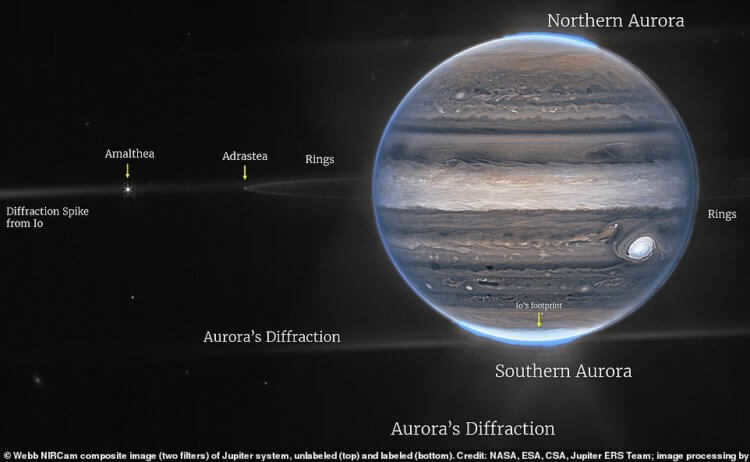

Take a look at this breathtaking sight! Right in front of us lies Jupiter and its immediate vicinity.
Dealing with Jupiter is actually more challenging compared to other celestial objects that are farther away because the planet rotates at a rapid pace. The process of combining multiple images into a single one is also arduous and time-consuming. According to an official statement from NASA, researchers often have to make adjustments to ensure the accuracy of the images.
In their press release, experts emphasize the opportunity to observe Jupiter from a fresh perspective. And this is only the beginning – the James Webb telescope is expected to revolutionize scientific discoveries for at least the next two decades.
During the summer nights, if you look up at the southern part of the sky, you will notice a remarkably bright star with a reddish or orange tint. This is none other than Jupiter, the biggest planet in our solar system.
Jupiter reigns supreme among all the planets. It resides in the fifth orbit from the Sun, and we owe a great deal to its presence for the harmony we experience. Jupiter falls under the category of gas giant planets, boasting a radius that is 11.2 times larger than that of Earth. In terms of mass, it is nearly 2.5 times heavier than all the other planets combined. Jupiter is accompanied by 67 known satellites, ranging from the very small to the exceptionally large.
Therefore, Jupiter holds the title of being the largest planet with the most mass, the most potent gravitational field, and the most significant influence in our solar system. It is also one of the most accessible and aesthetically pleasing objects to observe.
The History of Discovering Jupiter
It would be incorrect to speak of the discovery of Jupiter, as the planet has been visible in the sky since ancient times and was often mistaken for the brightest star. There is no specific discoverer for Jupiter since its existence has been known for centuries.
However, in 1610, Galileo Galilei was able to observe Jupiter’s four largest moons through his primitive telescope, which was a significant discovery. This marked the beginning of our understanding of Jupiter’s satellite system. Since then, astronomers and space probes have discovered over a dozen more moons orbiting the planet.
Amazing facts about Jupiter
The largest celestial body in our solar system undeniably possesses extraordinary characteristics. Without a doubt, this gigantic planet is so dissimilar to our minuscule Earth that fascinating facts about Jupiter are incredibly abundant. Here are a few of them:
- Jupiter is immensely massive. Its weight is equivalent to 318 times that of Earth. Even if you were to combine all the other planets and shape them into a single entity, Jupiter would still be 2.5 times heavier.
- The volume of Jupiter could accommodate 1,300 Earth-sized planets.
- Jupiter possesses 2.5 times the gravitational pull of Earth.
- Jupiter’s metallic core reaches temperatures of 20,000 degrees Celsius.
- Jupiter emits more heat than it receives from the sun.
- Jupiter does not have enough mass to become a star, as it requires 80 times its current mass to initiate a thermonuclear reaction in its core. Even if you combined all the planets, their moons, asteroids, comets, and other small debris in the solar system, there still wouldn’t be enough matter to make Jupiter a star.
- Out of all the planets in the solar system, Jupiter has the fastest rotation. Despite its massive size, it completes one full revolution in under 10 hours. This rapid rotation causes Jupiter to appear flattened at its poles.
- The thickness of the clouds on Jupiter is approximately 50 kilometers. The cloud layer has a visually impressive appearance. These immense storms and vibrant bands, spanning thousands of kilometers, exist within a relatively narrow layer. The composition of these features primarily consists of ammonia crystals, with the lighter crystals positioned below and the darker crystals forming as a result of solar radiation. Beneath this cloud layer lies a combination of hydrogen and helium with varying densities, which can transition into a metallic state.
- Giovanni Cassini first observed the Great Red Spot in 1665. This colossal storm has been in existence for at least 350-400 years, making it the largest and most enduring storm in the entire solar system. Although it has diminished by half in size over the past century, it still remains a prominent feature. In contrast, other storms on Jupiter typically last only a few days.
- After the well-known rings of Saturn and the much smaller rings of Uranus, Jupiter was also found to have rings. However, Jupiter’s rings are quite faint compared to those of other planets. Scientists believe that these rings are composed of material that was ejected from the planet due to meteorite impacts.
- Out of all the planets in our solar system, Jupiter boasts the strongest magnetic field, which is 14 times more powerful than Earth’s. This magnetic field is thought to be generated by a massive metallic core located at the center of the planet. The intense magnetic field is responsible for accelerating solar wind particles to nearly the speed of light. Consequently, this creates hazardous radiation belts in close proximity to Jupiter, posing a risk to spacecraft electronics and making it perilous to approach the planet.
- Jupiter boasts a remarkable number of satellites – as of 2018, there were 79 known. Scientists speculate there may be an abundance yet to be discovered. These satellites vary in size, ranging from those comparable to the Moon to mere fragments of rock measuring a few kilometers.
- Jupiter’s satellite Ganymede holds the title of being the largest satellite in the Solar System. With a diameter of 5260 km, it surpasses even Mercury by 8% and the Moon by a staggering 51%. It’s almost like having another planet.
- Thanks to its strong gravitational force, Jupiter serves as a protector against potential hazards such as comets and asteroids. By altering their orbits, it effectively cleanses the inner regions of the solar system, creating ample space for us. Comets and asteroids that venture towards us inevitably have their paths redirected by Jupiter, rendering them more rounded and safer for Earth.
- As evident, Jupiter is not just an ordinary gas ball. It is a complete planet with numerous enigmas and puzzles that scientists are progressively deciphering. In essence, this celestial body, along with its moons, resembles a scaled-down solar system, harboring countless distinctive worlds of its own. If you are curious, you can gather a significant amount of knowledge about Jupiter from this concise video:
Distance between Jupiter and the Sun
The distance between the Sun and the orbit of Jupiter is significantly greater than the distance between the Sun and the Earth’s orbit. While the Earth is approximately 150 million kilometers away from the Sun, or 1 astronomical unit, Jupiter is an average of 778 million kilometers away, or 5.2 astronomical units. Jupiter’s orbit is quite circular, with a difference in distance from the Sun of 76 million kilometers between its closest and farthest points.
A year on Jupiter lasts 11.86 Earth years, which is the time it takes for Jupiter to complete one revolution around the Sun. Every 13 months, Jupiter and Earth align, resulting in the minimum distance between the two, known as opposition. This is the optimal time to observe Jupiter.
Every 13 years, there is a remarkable event known as the Great Jupiter opposition. During this time, not only is Jupiter directly opposite the Earth, but it is also at the nearest point in its orbit. This occurrence is highly anticipated by astronomers, both professional and amateur, as it presents the perfect opportunity to observe and study this magnificent planet through telescopes.
Jupiter has a unique characteristic in that it has a very subtle inclination, measuring only around 3 degrees. As a result, the planet does not experience the same seasonal changes as Earth.
Distinctive Features of the Planet Jupiter
Jupiter is an incredibly intriguing celestial body that bears little resemblance to the familiar elements of our world.
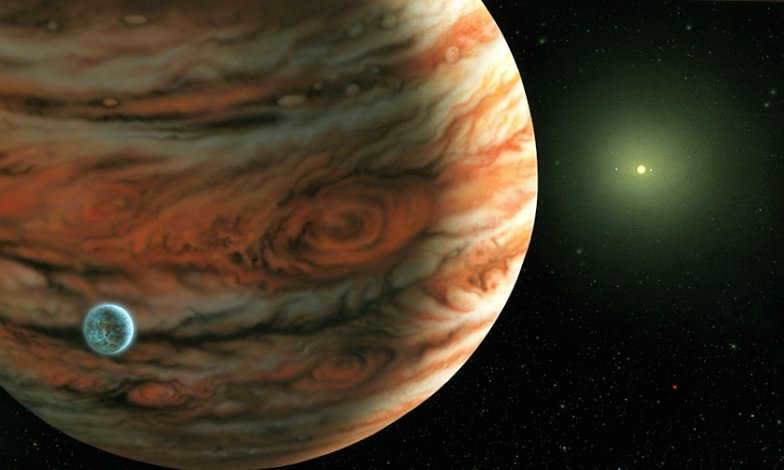
Comparing the sizes of Jupiter and Earth, we can see that Jupiter’s radius is approximately 70,000 kilometers, which is 11.2 times larger than Earth’s radius. Due to its rapid rotation, Jupiter has a slightly flattened shape, with a radius of around 66,000 kilometers at the poles and 71,000 kilometers at the equator.
When it comes to mass, Jupiter is 318 times heavier than Earth. If you were to gather all the planets, comets, asteroids, and other celestial bodies in the solar system into one pile, Jupiter alone would outweigh that pile by 2.5 times.
Jupiter has a surface area that is 122 times larger than Earth’s, but it is not solid and there is no place to land. Additionally, there is no distinct boundary. When descending onto Jupiter, the gas will simply condense under pressure, starting as a gaseous atmosphere and transitioning into a highly saturated fog before becoming a completely liquid medium.
In terms of magnetic field strength, Jupiter surpasses all other planets in the solar system with a field 14 times more powerful than Earth’s. The radiation emitted from Jupiter is so intense that even space probes cannot endure it for an extended period of time without experiencing equipment failures.
Jupiter’s Atmosphere is primarily composed of hydrogen (90%) and helium (10%), with traces of methane, hydrogen sulfide, ammonia, water, and other impurities. The lower layers of the atmosphere remain largely unexplored. The distinct red appearance of Jupiter is attributed to the presence of red phosphorus and its compounds. Experience the mesmerizing beauty of Jupiter’s atmospheric vistas in virtual form:
Jupiter’s Core is characterized by a temperature of approximately 3000 K and consists of molten metal, particularly metallic hydrogen. The size of the core surpasses that of Earth.
The Gravitational Acceleration on Jupiter would amount to about 2.5 times that of Earth’s gravitational pull.
What lies in store for an observer who dares to approach Jupiter? Initially, they would be treated to breathtaking vistas of the planet and its satellites, with the possibility of even glimpsing its majestic rings. However, as they drew closer to the planet, the intense radiation would prove fatal. Should their mortal form not remain trapped in eternal orbit, but instead enter Jupiter’s atmosphere, they would be met with a barrage of fire, tremendous pressure, and a lengthy descent of whatever fragments are left. Alternatively, it might not be a descent at all, but rather a tumultuous hurricane that carries the remnants until the atmospheric composition breaks them down into individual molecules.
The Great Red Spot of Jupiter
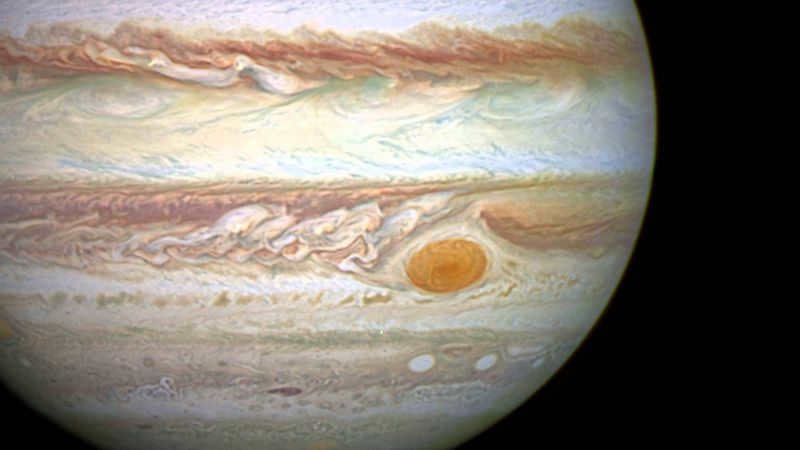
One of the most intriguing occurrences on Jupiter, which can be seen even with a moderate telescope, is the phenomenon known as the Great Red Spot. This massive storm is visible on the planet’s surface and rotates along with it. With dimensions that can vary, the Great Red Spot spans approximately 40,000 kilometers in length and 13,000 kilometers in width – large enough to engulf the entire Earth within its colossal hurricane!
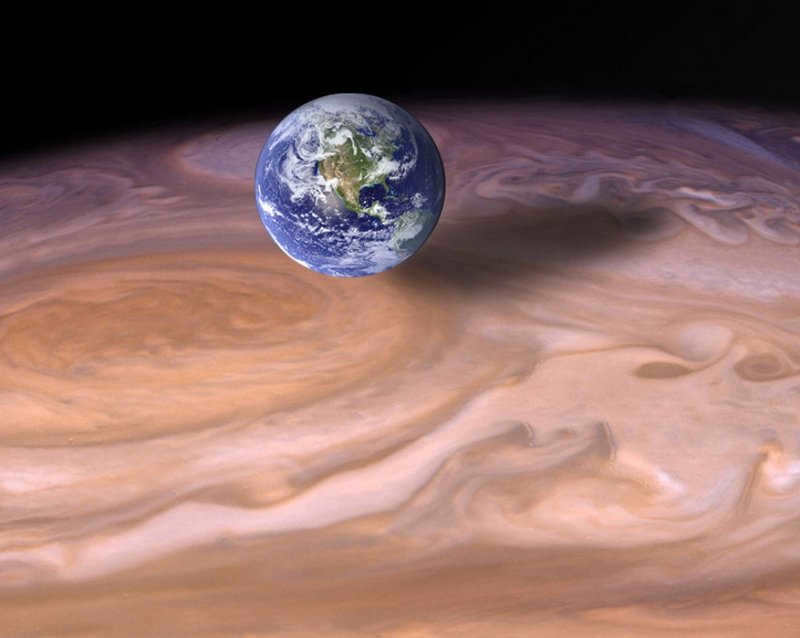
A comparison of the size of the Great Red Spot on Jupiter reveals its remarkable longevity. This extraordinary phenomenon has been observed for over three centuries, and despite its persistent presence, it has not diminished. Initially believed to be a solid formation on the planet’s surface, detailed images captured by Voyager 1 in 1979 revealed the truth. The Great Red Spot is, in fact, an atmospheric vortex, making it the largest hurricane in our entire solar system. Its existence predates human observation, and its true age remains a mystery. Interestingly, over the past century, the size of this astonishing sunspot has actually halved.
In addition to its size, the Great Red Spot also exhibits a unique rotational pattern. It completes a full revolution around its axis every six hours, all while harmoniously rotating with the planet itself.
The hurricane’s winds in this storm reach speeds of 500-600 km/h (approximately 170 m/s). In comparison, our most powerful terrestrial hurricanes are merely gentle breezes. However, in the center of the storm, similar to Earth hurricanes of this kind, the weather is relatively calm. Interestingly, on the icy planet Uranus, the winds are even stronger.
Aside from the Great Red Spot on Jupiter, there are other similar formations known as hurricanes. They are created in various regions and can persist for decades before gradually dissipating. Occasionally, these hurricanes collide with one another or even with the Great Red Spot, causing changes in its brightness and size. The longest-lasting whirlwinds tend to form in the southern hemisphere, though the reasons behind this phenomenon remain unclear.
Jupiter’s Moons
Jupiter, the colossal planet, boasts an extensive entourage, befitting a true deity. Currently, there are 79 known moons of varying sizes and shapes orbiting this gas giant – ranging from massive bodies comparable to our own Moon, to small rocky fragments measuring just a few kilometers, akin to asteroids. Each of these moons bears a name associated with the mythical god Zeus-Jupiter. Scientists speculate that there may be even more undiscovered moons, although this already stands as a record-breaking number among all the planets in our solar system.
Ever since Galileo Galilei’s groundbreaking discovery of Jupiter’s initial and largest moons – Io, Europa, Ganymede, and Callisto – in 1610, these have remained the only known satellites. Remarkably, they can be observed with the naked eye, and become even more discernible when viewed through a modest telescope.
Each of the moons orbiting Jupiter is incredibly fascinating and represents a distinct and unique world. Some scientists even speculate that these moons may harbor conditions conducive to the development of life, prompting them to develop plans for probes to conduct more in-depth studies.
Back in the 1970s, astronomers were aware of the existence of 13 satellites orbiting Jupiter. However, it wasn’t until Voyager 1 flew past Jupiter that three additional moons were discovered. The 1990s brought about the advent of powerful new telescopes, such as the Hubble Space Telescope, which allowed for the detection of several dozen more small satellites orbiting Jupiter. Many of these newly discovered moons are only a few kilometers in size, making it virtually impossible for amateur astronomers to spot them using their own telescopes.
The future of Jupiter
Currently, Jupiter is not considered to be in the habitable zone due to its distance from the Sun and the inability of its satellites to support liquid water on their surfaces. However, there is speculation that subsurface oceans may exist on Ganymede, Europa, and Callisto.
In the future, as the Sun expands and moves closer to Jupiter, the satellites of Jupiter will gradually warm up. This could lead to the creation of more favorable conditions for the development and sustainability of life on some of these satellites.
However, in the future, more advantageous circumstances will arise on the satellites of Saturn, with one of them, Titan, currently serving as a thriving organic factory boasting a dense atmosphere. It is possible that new life forms will emerge there as well.
Observing Jupiter
This celestial body is extremely accessible for amateur astronomers who are just starting out. It can be seen in the southern part of the sky and rises to a considerable height above the horizon. In terms of brightness, Jupiter is second only to Venus. The most opportune moments for observations are during oppositions, when the planet is at its closest proximity to Earth.
Jupiter’s oppositions:
It is fascinating to observe the planet Jupiter, even with binoculars. On a dark night, a magnification of 8-10x will enable you to spot the four Galilean satellites – Io, Europa, Ganymede, and Callisto. Unlike other stars, the planet’s disk is visible and does not appear as just a dot. However, it is important to note that at such magnifications, it is not possible to see the finer details through binoculars.
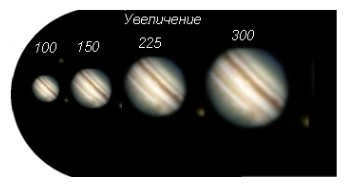
By equipping yourself with a telescope, you can witness an even more spectacular view. Take for instance the Sky Watcher 909 refractor with a 90-mm aperture and a 25-mm eyepiece (resulting in a 36x magnification). With this setup, you will be able to observe a variety of stripes on Jupiter’s surface. If you switch to a 10-mm eyepiece (which offers a magnification of 90x), you’ll be able to discern even more intricate details, such as the famous Great Red Spot and the shadows cast by Jupiter’s satellites on its surface.
Having larger telescopes at our disposal will undoubtedly enable us to observe Jupiter with greater precision. The planet’s belts will be more discernible, and even the fainter satellites will become visible. Furthermore, with a high-powered instrument, one can obtain impressive images of Jupiter. It’s worth noting, however, that using a telescope with a diameter exceeding 300 mm is futile as atmospheric interference will hinder the ability to observe additional details. Most amateur astronomers opt for a reflector telescope with a diameter of 150 mm or more when studying Jupiter.
To enhance the viewing experience, it is recommended to utilize light filters with a blue or blue hue. These filters render the Great Red Spot and the belts more distinct. Light red filters prove beneficial in capturing the nuances of the blue shade, while yellow filters are optimal for observing the polar regions. Lastly, green filters accentuate the contrast of the cloud belts and the Great Red Spot.

